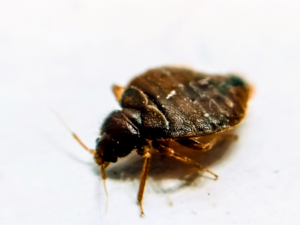Home / Blog / Scorpions / From Pincers to Tail: Scorpions in Arizona
From Pincers to Tail: Scorpions in Arizona

Scientifically reviewed by Daniel Baldwin, BCE, CCFS, CP-FS
-Published on May 22, 2023
-Updated on July 13, 2023
The hot, dry climate of Arizona is an ideal place for scorpions to live. Although these members of the arachnid family look intimidating, most species of scorpions in Arizona are harmless to humans. However, there are still some dangerous ones in the Grand Canyon State. In this post, we’ll explore the scorpions you’re most likely to encounter in Arizona so you know what to do if you encounter one in your home or outside.
Are there scorpions in Arizona?
Scorpions are arachnids that have six legs, large pincers in the front, and a long tail outfitted with a stinger. Around 40 to 60 species of scorpions live in Arizona. They prefer to make their homes in dark, secluded places outdoors, but can find their way into homes, where they may hide in cardboard boxes, attics, crawlspaces, curtains, and potted plants.
The good news is that there aren’t many species of deadly scorpions in Arizona. In fact, only one of the many types found in the state poses health risks to humans. That species is the Arizona bark scorpion. Keep reading to learn more about common Arizona scorpions.
Types of scorpions in Arizona
The following are the most commonly encountered scorpions in Arizona.
Arizona bark scorpion
The Arizona bark scorpion (Centruroides sculpturatus) is a skilled climber that typically makes its home under rocks, in rock crevices, and high up in trees. However, they may also end up in bathtubs, closets, and stone walls in homes.
Adults can reach lengths of 2 to 3 inches. Their bodies are tan, with slightly darker markings appearing along their backs. Under a black light, the species gives off a fluorescent green glow, making this an easy way to identify the pests.
Although stings from Arizona bark scorpions can be dangerous, serious reactions primarily impact children and older adults. In fact, bark scorpions in Arizona typically only cause around 100 bites that require antivenom treatment each year.

Arizona giant hairy scorpion
At 4 to 7 inches in length, the Arizona giant hairy scorpion (Hadrurus arizonensis) is the largest common species of scorpion in Arizona. In addition to being larger than the Arizona bark scorpion, the giant hairy species usually has a darker body and small hairs that grow along its pincers.
Arizona giant hairy scorpions often make their homes in abandoned animal burrows and small caves. However, they will also take up residence in potted plants and lawns, where they feed on beetles and other insects. Their venom can paralyze prey but is unlikely to cause harm to humans.

Arizona stripe-tail scorpion
The Arizona stripe-tail scorpion (Paravaejovis spinigerus) can be mistaken for the bark scorpion at a quick glance due to their similar coloring and size. However, the species has a stouter, rounder body, and bulkier pincers. They typically make their home in areas with sandy soil. If threatened, they will sting, but their venom typically doesn’t pose health risks for humans.

Yellow ground scorpion
Like the Arizona stripe-tail, the yellow ground scorpion (Vaejovis confusus) often gets mistaken for bark scorpions in Arizona because the species is about the same size and has a yellowish-tan body with dark markings. The biggest difference between the two is that the yellow ground scorpion has a thicker tail.
You’re most likely to encounter the yellow ground scorpions in sandy places, where they create shallow burrows called scrapes to hide and wait for prey. If provoked, the species will sting but is unlikely to cause serious injury to people like the majority of scorpions in Arizona.

Are all scorpions venomous?
Scorpions use their venom to stun their prey and to defend themselves from predators. All scorpions in Arizona are venomous, but only the Arizona bark scorpion’s sting is known to cause serious reactions in humans. Stings from other species may be painful and cause minor swelling and redness.
What eats scorpions in Arizona?
Although they have stingers for protection, scorpions in Arizona do provide a source of food for other wildlife. Tarantulas, large centipedes, bats, shrews, mice, lizards, owls, and other birds commonly feed on scorpions.
How to get rid of scorpions
To reduce the risk of Arizona scorpions in your house and around your property, follow these tips.
Remove hiding places
Scorpions seek out dark hiding places, so cleaning up clutter around your property can make your yard less attractive to them. Pick up trash, eliminate fallen logs, and minimize the number of flower pots and decorative accents you place in your garden and outdoor living spaces. Also, keep firewood covered and stored off the ground.
Deal with other pest problems
As predators, scorpions look for places where insects and spiders are present. If you have an indoor or outdoor pest problem, address those pests to limit scorpions’ access to food.
Maintain your lawn
A well-cared-for lawn and landscaping gives scorpions fewer places to hide. Mow the grass regularly, and keep shrubbery trimmed to make your property less appealing.
Secure your trash
Trash cans can be good hiding places and food sources for scorpions. Store yours on a platform off the ground, and be sure to cover them with tight-sealing lids.
Address entry points
To make it less likely that scorpions will enter your home, repair any structural problems like cracks and gaps. Ensure that the weatherstripping along doors and windows is in good condition, and inspect screen doors and window screens for holes.
Call a professional pest control company
A professional pest control company can treat your home and outdoor living spaces to address existing infestations and discourage scorpions from nesting. Knowledgeable pest control technicians can identify the specific species of Arizona scorpions in a house or outdoor area and then choose the most effective treatments for controlling them.
Scorpion control services
Hawx Pest Control can assist you with scorpion problems. Our licensed pest control technicians have access to state-of-the-art technologies, proven tools, and high-quality products to treat scorpions. In addition, they can provide you with advice on how to deter scorpions in the future and recommend a maintenance treatment plan for ongoing control as needed.
Related Articles
Visit our blog to learn more.
→





